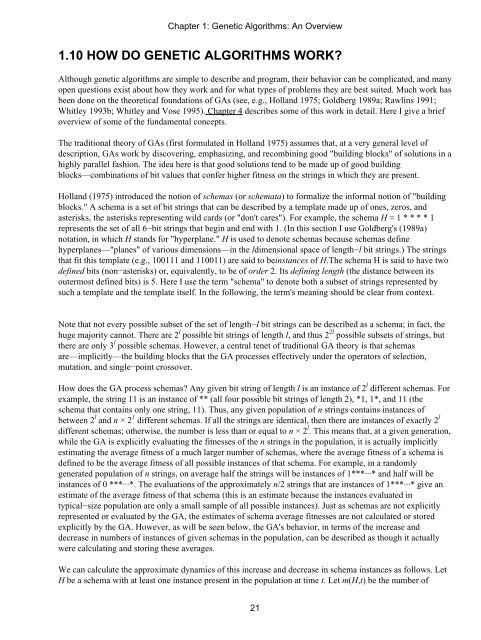An Introduction to Genetic Algorithms - Boente
An Introduction to Genetic Algorithms - Boente
An Introduction to Genetic Algorithms - Boente
Create successful ePaper yourself
Turn your PDF publications into a flip-book with our unique Google optimized e-Paper software.
Chapter 1: <strong>Genetic</strong> <strong>Algorithms</strong>: <strong>An</strong> Overview<br />
1.10 HOW DO GENETIC ALGORITHMS WORK?<br />
Although genetic algorithms are simple <strong>to</strong> describe and program, their behavior can be complicated, and many<br />
open questions exist about how they work and for what types of problems they are best suited. Much work has<br />
been done on the theoretical foundations of GAs (see, e.g., Holland 1975; Goldberg 1989a; Rawlins 1991;<br />
Whitley 1993b; Whitley and Vose 1995). Chapter 4 describes some of this work in detail. Here I give a brief<br />
overview of some of the fundamental concepts.<br />
The traditional theory of GAs (first formulated in Holland 1975) assumes that, at a very general level of<br />
description, GAs work by discovering, emphasizing, and recombining good "building blocks" of solutions in a<br />
highly parallel fashion. The idea here is that good solutions tend <strong>to</strong> be made up of good building<br />
blocks—combinations of bit values that confer higher fitness on the strings in which they are present.<br />
Holland (1975) introduced the notion of schemas (or schemata) <strong>to</strong> formalize the informal notion of "building<br />
blocks." A schema is a set of bit strings that can be described by a template made up of ones, zeros, and<br />
asterisks, the asterisks representing wild cards (or "don't cares"). For example, the schema H = 1 * * * * 1<br />
represents the set of all 6−bit strings that begin and end with 1. (In this section I use Goldberg's (1989a)<br />
notation, in which H stands for "hyperplane." H is used <strong>to</strong> denote schemas because schemas define<br />
hyperplanes—"planes" of various dimensions—in the ldimensional space of length−l bit strings.) The strings<br />
that fit this template (e.g., 100111 and 110011) are said <strong>to</strong> beinstances of H.The schema H is said <strong>to</strong> have two<br />
defined bits (non−asterisks) or, equivalently, <strong>to</strong> be of order 2. Its defining length (the distance between its<br />
outermost defined bits) is 5. Here I use the term "schema" <strong>to</strong> denote both a subset of strings represented by<br />
such a template and the template itself. In the following, the term's meaning should be clear from context.<br />
Note that not every possible subset of the set of length−l bit strings can be described as a schema; in fact, the<br />
huge majority cannot. There are 2 l possible bit strings of length l, and thus 2 2l possible subsets of strings, but<br />
there are only 3 l possible schemas. However, a central tenet of traditional GA theory is that schemas<br />
are—implicitly—the building blocks that the GA processes effectively under the opera<strong>to</strong>rs of selection,<br />
mutation, and single−point crossover.<br />
How does the GA process schemas? <strong>An</strong>y given bit string of length l is an instance of 2 l different schemas. For<br />
example, the string 11 is an instance of ** (all four possible bit strings of length 2), *1, 1*, and 11 (the<br />
schema that contains only one string, 11). Thus, any given population of n strings contains instances of<br />
between 2 l and n × 2 1 different schemas. If all the strings are identical, then there are instances of exactly 2 l<br />
different schemas; otherwise, the number is less than or equal <strong>to</strong> n × 2 l . This means that, at a given generation,<br />
while the GA is explicitly evaluating the fitnesses of the n strings in the population, it is actually implicitly<br />
estimating the average fitness of a much larger number of schemas, where the average fitness of a schema is<br />
defined <strong>to</strong> be the average fitness of all possible instances of that schema. For example, in a randomly<br />
generated population of n strings, on average half the strings will be instances of 1***···* and half will be<br />
instances of 0 ***···*. The evaluations of the approximately n/2 strings that are instances of 1***···* give an<br />
estimate of the average fitness of that schema (this is an estimate because the instances evaluated in<br />
typical−size population are only a small sample of all possible instances). Just as schemas are not explicitly<br />
represented or evaluated by the GA, the estimates of schema average fitnesses are not calculated or s<strong>to</strong>red<br />
explicitly by the GA. However, as will be seen below, the GA's behavior, in terms of the increase and<br />
decrease in numbers of instances of given schemas in the population, can be described as though it actually<br />
were calculating and s<strong>to</strong>ring these averages.<br />
We can calculate the approximate dynamics of this increase and decrease in schema instances as follows. Let<br />
H be a schema with at least one instance present in the population at time t. Let m(H,t) be the number of<br />
21






